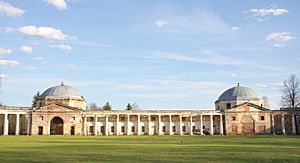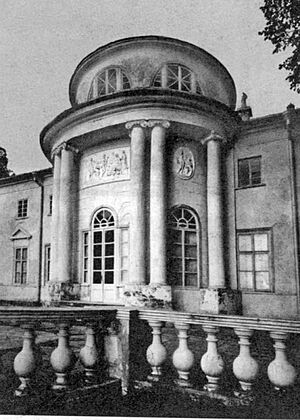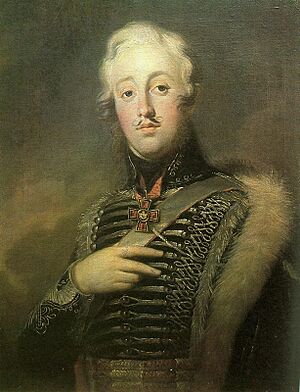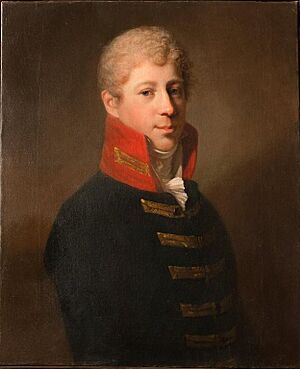Fyodor Glebov facts for kids
Quick facts for kids
Fyodor Ivanovich Glebov
|
|
|---|---|
 |
|
| Personal details | |
| Born | December 31 1734 |
| Died | November 29 1799 |
| Resting place | Donskoy Monastery, Moscow |
| Spouses | 1) Alexandra Ivanovna Dashkova 2) Yelizaveta Petrovna Streshneva |
| Children | from first marriage: Aleksandra from second marriage: Pyotr and Dmitry |
| Parents |
|
| Awards | Order of Saint Alexander Nevsky, Order of Saint Anna, Order of the White Eagle (Poland), Order of St. Stanislaus (Poland) |
| Military service | |
| Rank | Major-General (1764), lieutenant general (1773), general-in-chief (1782) |
| Battles/wars | Seven Years' War (1756—1763) Russo-Turkish War (1768–1774) |
Fyodor Ivanovich Glebov (born December 31, 1734 – died November 29, 1799) was an important Russian general and statesman. He served under Catherine the Great, becoming a general-in-chief in 1782. He was also a senator and built the famous Znamenskoye-Rayok Estate. Fyodor Glebov was one of the most powerful and wealthy members of the Glebov family.
Contents
Life of Fyodor Glebov
Fyodor Glebov was born into a military family. His father, Ivan Glebov, was also a general. Fyodor was the second of four brothers.
Early Military Career
Fyodor began his military journey very young. At just 7 years old, in 1742, he was listed as a soldier in the artillery. By 1747, he was promoted to sergeant. In 1750, he became an officer in the artillery.
In 1751, Fyodor Glebov moved to New Serbia. There, he worked as an engineering officer. He helped his father build a fortress in Kropyvnytskyi.
He continued to rise through the ranks. In 1753, he became a podporuchik. By 1757, he was a captain.
Seven Years' War Service
In June 1757, Glebov was sent to join the French army in Westphalia. He was promoted to major in 1758 and returned to Russia that same year.
He fought bravely in the Seven Years' War.
- On August 14, 1758, he took part in the Battle of Zorndorf.
- After his actions in this battle, he was promoted to podpolkovnik in the artillery in 1759.
- In 1760, he served in a special military group and helped with the Raid on Berlin.
- In 1761, he helped capture the city of Swidnica.
In 1762, Glebov became a colonel of artillery. By 1764, he was a major general. From 1765 to 1767, he served in the Moscow region.
Russo-Turkish War and Later Years
In 1769, Glebov joined the Russo-Turkish War. He served in the first Russian army. He helped in the Siege of Khotyn. Glebov stayed near Khotyn even when the Russian army had to retreat. He led his soldiers to defeat an enemy attack and chased them to the Prut River.
On August 29, 1769, Major General Glebov led five cavalry regiments. They helped defeat the Turkish army. For this victory, he received the Order of Saint Anna. In 1770, he commanded four infantry regiments. He helped keep communication lines open for Russian troops. On July 21, 1770, he fought in the Battle of Kagul, where the Turkish-Tatar army was defeated.
Later in 1770, Glebov was ordered to capture the city of Braila. He began a siege on September 26. The Turks attacked often, but Glebov's forces fought them off. His first attack on the city failed, and many soldiers were hurt. However, after getting more troops, Glebov laid siege to Braila again. The Turks left the city, and Russian troops entered Braila on November 10, 1770.
In 1773, Glebov was promoted to lieutenant general. He also took part in the Siege of Silistria.
Political and Final Years
In 1775, Glebov commanded Russian troops in Poland. He received two awards from the Polish king: the Order of the White Eagle and the Order of Saint Stanislaus. He then served in Finland and commanded a division in Tallinn in 1777.
On July 28, 1781, Fyodor Glebov became a senator. This meant he was part of a very important government body. In 1782, he was promoted to general-in-chief. He also received the Order of Saint Alexander Nevsky.
Due to illness, Glebov left the Senate in 1791. He officially retired from service in 1794.
Fyodor Ivanovich Glebov passed away on November 29, 1799. He was buried in the Donskoy Monastery in Moscow. A poet wrote two poems in his memory.
Gustav von Strandmann, who served with Glebov, described him as a very kind person.
He is one of the most good-natured people that I have ever seen. He and his wife were very courteous with subordinates, and both enjoyed great respect in Tallinn, for both their friendliness and their politeness, and especially for the fact that they lived opulently and received guests every day. He was terribly fond of playing cards.
Family Life
Fyodor Glebov was married twice and had several children.
First Marriage
In 1765, he married Aleksandra Ivanovna Dashkova. They had one daughter:
- Aleksandra (1766—1796): She married Major General Dmitry Mikhailovich Shcherbatov in 1787.
Second Marriage
Three years after his first wife died, Fyodor Glebov married Yelizaveta Glebova-Streshneva (1751–1837). She inherited the Pokrovskoye-Streshnevo Estate near Moscow. Glebov built a manor house for her near Pokrovsky Park, naming it in her honor.
They had four children together, but two of them died when they were very young. Their two sons who lived were:
- Pyotr Fydorovich Glebov-Streshnev (1773–1807): He became a major general. He died from wounds he received in battle.
- Dmitry Glebov-Streshnev (1782–1816): He never married or served in the military.






